Wallasey Corporation Tramways, No. 78
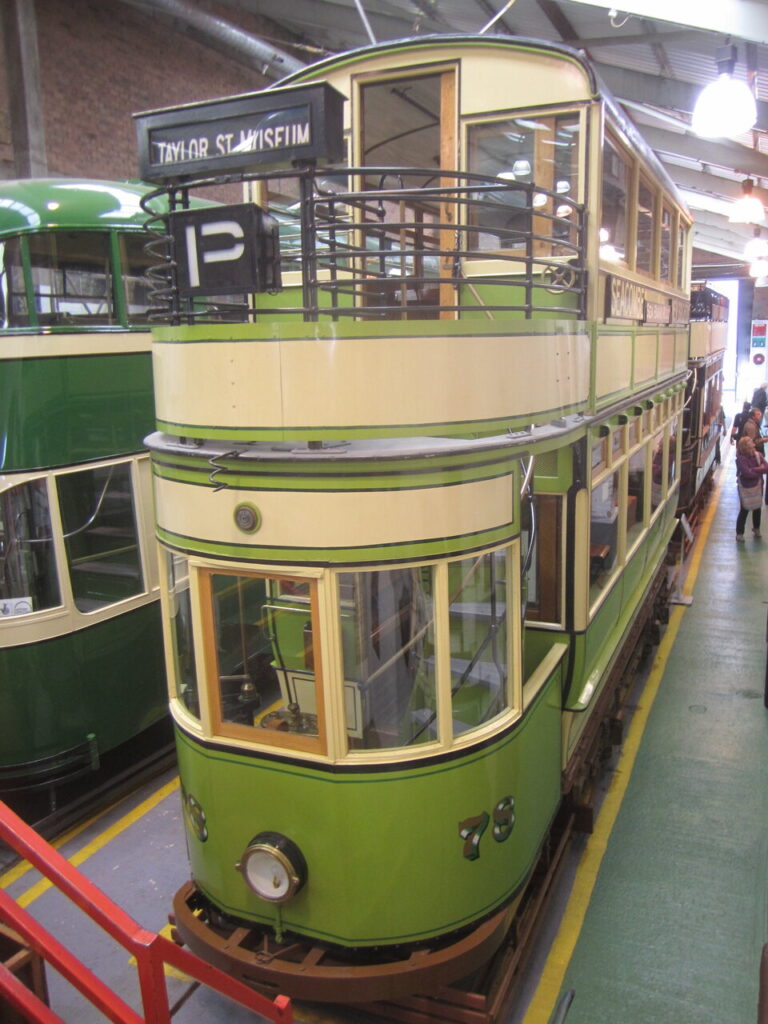
Wallasey 78 with its distinctive Bellamy top cover photographed at the Wirral Tramway Museum by Jim Dignan on 18th April 2015.
Wallasey 78 is a unique survivor that also represents an important “missing link” in the evolution of British double deck tramcars.
Built by the Brush Electrical Engineering Company based in Loughborough, it was already decidedly outdated when it rolled off the production line in 1920 as most of its contemporaries were already completely top-covered, if not fully enclosed, by then.
It was also the last in a long line of broadly similar tramcars that had made up the Wallasey Corporation fleet since the first trams were ordered from the Preston-based Electric Railway and Tramway Carriage Works in 1901. The initial batch of 30 tramcars was delivered in 1902-3 with open top decks, as was standard practice at the time.
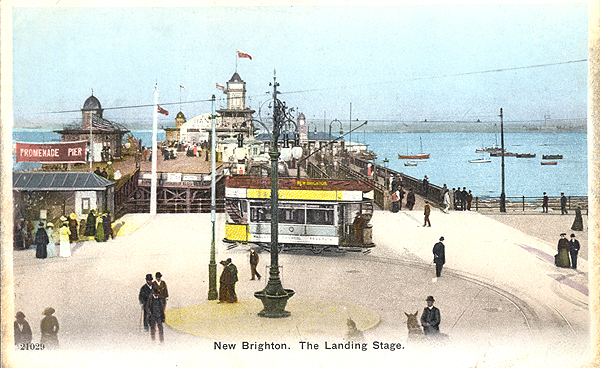
A postcard showing an early open-topped tramcar at Wallasey’s New Brighton pier and landing stage. Crich Tramway archives.
One of the cars was given a top cover in 1903, before entering service, however, and the increased revenue earned by this car persuaded the Council to approve the fitting of top covers to the entire fleet, an exercise that was completed by May 1905. This speedy conversion process made Wallasey one of the first operators in the country to achieve such a feat.
Other tramway operators experimented with various attempts to provide top deck passengers with much-needed protection against the vagaries of the British climate, some of which looked to have been inspired by contemporary cartoonist W. Heath Robinson.
Wallasey, however, opted from the outset for a solid Bellamy-style roof cover that left the upper deck balconies and stairwells open but provided ample protection from the elements for those seated within. All subsequent additions to the fleet were built to a similar design, making Wallasey 78 the last tramcar in the country to be built with a Bellamy roof and Wallasey almost certainly the last tramway to operate an entire fleet of Bellamy-roofed tramcars.
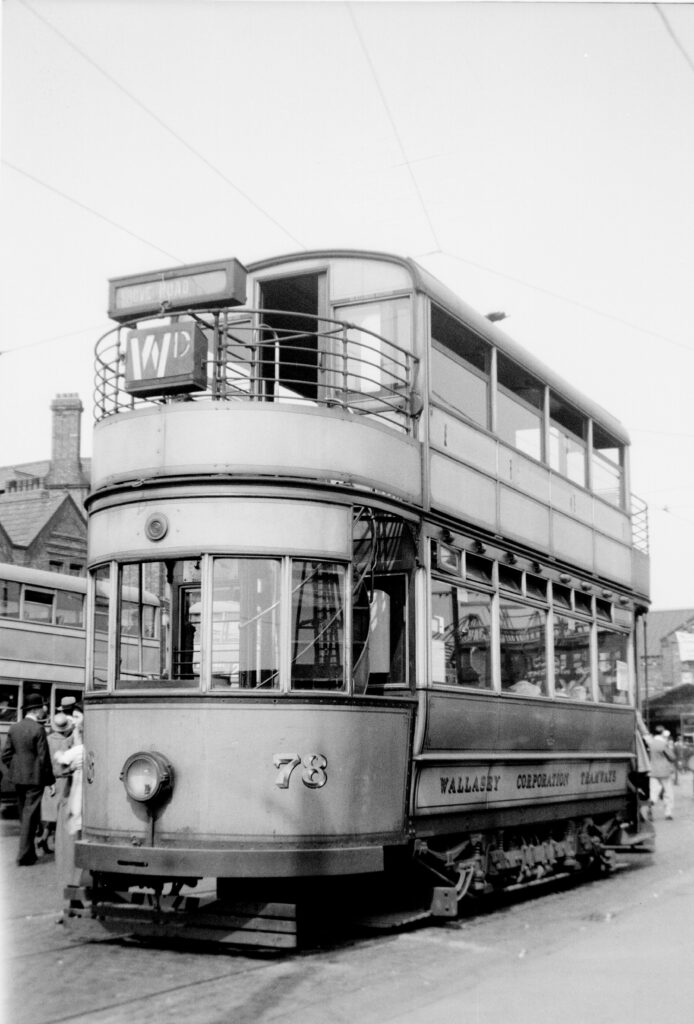
Wallasey 78 with its Bellamy-style roof cover, photographed at Seacombe by M.J. O’Connor, date unknown. Crich Tramway archives.
Ironically, the seemingly daunting challenge of providing protection for upper deck passengers stemmed from the fact that early electric tramcars evolved directly from their horse-drawn predecessors, which they closely resembled in appearance, and which had to be light-weight or the horses couldn’t cope. Covered upper decks were therefore out of the question.
Had they evolved from steam-hauled tramcars the problem presumably wouldn’t have arisen as their trailers had long been top-covered and fully enclosed – to protect upper deck passengers from the soot and smoke produced by the steam locomotive in front – from as early as 1887. The museum’s Dundee and District Tramways fully enclosed steam tram trailer, for example, dates back to 1894. This was almost a decade before the first top covers were devised for electric tramcars, even though it was built by G.F. Milnes & Co., which later switched to electric tramcar production.
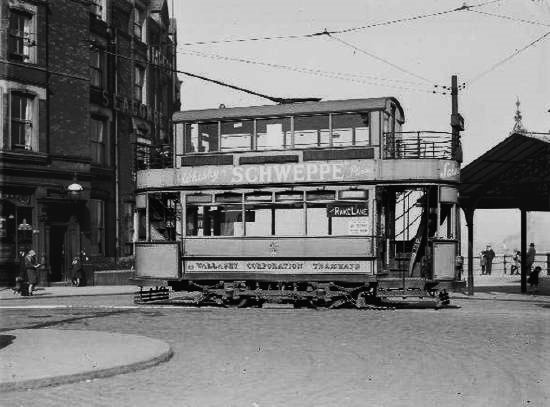
A photograph of Wallasey 61, built in 1913, showing the side profile of the Bellamy roof cover, taken by H. Nicol at Seacombe Ferry Terminus, date unknown. Crich Tramway archives.
The rationale for retaining such an outmoded design was said to be that the public preferred open balcony cars in summer weather in the popular holiday destination. Much of the tramway’s traffic was generated by the borough’s three ferries and the tramcars operating these services even carried flags attached to their trolley ropes to warn passengers if incoming ferries were suspended due to adverse weather conditions.
By the time the final batch of 20 new Brush tramcars were ordered for the Wallasey fleet in 1920, inflation was pushing up costs, which prompted the Council to cancel half the batch and reconstruct some of its older tramcars instead.
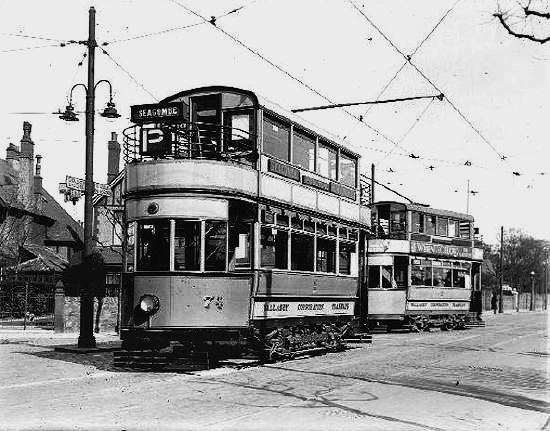
Sister car no. 74 together with an unidentified Bellamy-roofed car photographed by H. Nicol at Seacombe Road, date unknown. Crich Tramway archives.
As a result, Wallasey 78 was the last addition to the fleet. Although it resembled the previous batch (nos. 63-8) – built in 1915 – in most respects, it had 180-degree direct stairs instead of the reversed stairs fitted to its predecessors and, as a result, could accommodate ten passengers on its balcony seats instead of 8, increasing its capacity by two to 68.
In common with the rest of the fleet, No. 78 was turned out in the same unusual sea-green livery, a colour that the Preston-based manufacturers had devised. Whether this was the colour that the tramway had intended to specify has been the subject of some debate over the years, however, as a possibly apocryphal story relates that, when asked by a company representative what colour the trams should be painted, he was told, “Oh, see Greene”, which happened to be the name of the Tramway Manager at the time.
Although the order of this final batch of tramcars may have represented a vote of confidence in the future of the tramway, the state of the track was sadly run down after years of war-time neglect. It was caught between the conflicting priorities of the Borough Engineer, who was responsible for the track, and the Tramways Committee, who held the purse strings.
This resulted in a decision in 1919 to weld and harden five of the most heavily used sections of track, which brought short-term relief but precipitated the end of the tramway nearly a decade later when these by now life-expired parts of the network had to be abandoned and were replaced by motor buses. This undermined the viability of the remainder of the network, which was finally abandoned on 30th November 1933.
Number 78 was provisionally withdrawn on closure of the Seabank Road route in January 1929 and, together with the other 9 cars from the 1920 batch, offered for sale elsewhere as they were by then less than a decade old. In the absence of a buyer, however, they returned to service and 78 survived until the end of the line. It was then sold to Messrs Grahamsley, who dismantled it in 1934 and resold the lower saloon to a farmer in North Wales for storage purposes.
It was acquired by the Merseyside Tramways Preservation Trust just over half a century later, in 1986 when some initial restoration work was undertaken. A grant from the Heritage Lottery Fund in 1997 financed an ambitious full restoration of the historic tramcar, enabling it to enter service on the Wirral Heritage Tramway in August 2002.
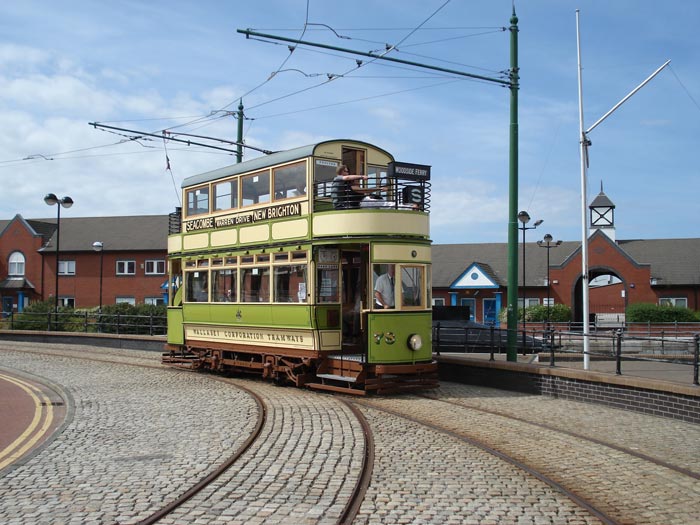
Wallasey 78 in service on the Wirral Heritage Tramway. Photo courtesy of the Merseyside Tramways Preservation Society.
Unfortunately, the Wirral Tramway has endured a somewhat precarious existence as a result of successive rounds of financial cuts that have afflicted Wirral Borough Council since it first established the attraction with the aid of European funding in 1995. Indeed, it was first threatened with closure in 2009, when both Museum and Tramway were initially put up for sale and a proposed sale to Merseytravel eventually fell through after protracted negotiations.
A rescue plan was eventually agreed that involved the operation and management of the facility being undertaken from January 2014 by volunteers from the Merseyside Tramway Preservation Society on behalf of the Council as part of a proposed asset transfer arrangement.
A major refurbishment of the museum subsequently took place over a six-month period that ended on 21st July 2018. However, a further round of council funding cuts sadly resulted in both tramway and museum being closed once more in April 2023 with custodianship and management of the facility being transferred from the MTPS to Big Heritage, a not-for-profit social enterprise company.
This coincided with an inspection carried out by the Office of Road and Rail which resulted in a requirement to complete an extensive programme of work to address a number of health and safety and related issues, in addition to the major restructuring of the museum itself that Big Heritage is undertaking.
Subsequently, several vehicles have had to be rehomed, either temporarily or permanently, some of which belonged to the MTPS. They include three tramcars with strong links to the Merseyside area, one of which is Wallasey 78.
Following extensive deliberations and conversations with interested parties in autumn 2024, the MTPS very generously donated all three to the Tramway Museum Society, where they will join Liverpool 869 – another tramcar that was rescued and preserved by the MPTS with further subsequent restoration being undertaken by the TMS at Crich.
Given its unique status as the only surviving Bellamy-roofed tramcar – demonstrating the “missing link” between Britain’s earliest double decked electric tramcars, all of which were open topped, and the fully enclosed ones that emerged during the early years of the twentieth century – Wallasey 78 is an invaluable addition to the already extensive collection of historic tramcars at Crich.
Specification
- Type of tram
- Electric double deck 4-wheeled tramcar with partial Bellamy top cover (originally open-topped).
- Livery
- Sea-green and cream
- Seating capacity
- 68 (26 downstairs; 42 upstairs)
- Date built
- 1920
- Manufacturer of body
- Brush Electrical Engineering Co., Loughborough
- Manufacturer of truck
- Peckham Pendulum P22
- Gauge
- 4’ 8½”
- Motor
- Brush 1210J 2x45hp
- Controller
- Brush 8B
- Current collector
- Trolley Pole
- Withdrawn from service
30th November 1933
- Subsequent history
Lower deck of 78 sold to a farm in North Wales; acquired by the MTPS in 1986.
- Restoration history
Restoration carried out intermittently by the MTPS and completed in 2002 with the aid of Heritage Lottery funding.
- Current status
- Restored to operational condition by the MTPS and has seen regular service on the Wirral Heritage Tramway
- Date started operating at Crich
- N/A
- Total mileage covered at Crich
- N/A
- Current location
- Crich depots
- Future plans
Likely to be assessed and overhauled if required once it arrives at Crich with a view to returning it to operational service if possible.
- 1920 – 1933Fully operational on original tramway
- 1933 – 1986 Lower deck sold off to a farm and used for storage
- 1987 – 1988 Initial restoration commenced following its acquisition by the MTPS
- 1988 – 1997 In storage awaiting funding
- 1997 – 2002 Undergoing restoration
- 2002 – 2023 Operational at the Wirral Heritage Tramway
- 2023 – 2025 In storage at the Wirral Heritage Tramway
- 2025 On display and undergoing assessment at Crich Tramway Museum
